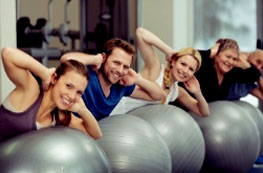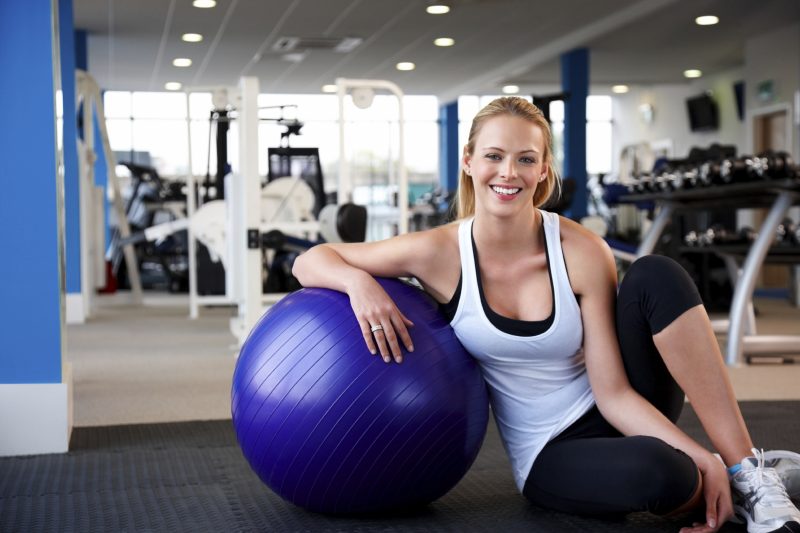We all head to the gym in the hope of improving our health and fitness! However we physiotherapists can occasionally see people coming out worse for wear after their gym program!
So what are the 5 most common injuries that we physiotherapists see related to gym training? And even more important, how can you avoid these common injuries?
NUMBER ONE
Culprit: TRICEP DIPS
Problem area: Shoulder pain, rotator cuff injury and bursitis
Tricep  Dips are the most common way of injuring the delicate shoulder tendons and bursa! We have 4 small rotator cuff tendons that hold the ball stable in the socket and a bursa that lies nearby to protect the underside of our bony collarbone. When doing a tricep dip, this can force or jam the ball up and forward into the socket which can pinch the bursa and can contribute to wear and tear on the rotator cuff tendons. Tricep dips are our number one cause of shoulder pain in the gym.
Dips are the most common way of injuring the delicate shoulder tendons and bursa! We have 4 small rotator cuff tendons that hold the ball stable in the socket and a bursa that lies nearby to protect the underside of our bony collarbone. When doing a tricep dip, this can force or jam the ball up and forward into the socket which can pinch the bursa and can contribute to wear and tear on the rotator cuff tendons. Tricep dips are our number one cause of shoulder pain in the gym.
Solution: Avoid the Tricep Dip machine and simply try tricep pull downs, or supine overhead triceps to get rid of the bingo wings, this is a much safer way of exercising the triceps without potentially damaging the shoulder.
NUMBER TWO
Culprit: DEAD LIFTS
Problem area: Lumbar disc injuries and hamstring tendon tears
 If you are one of these people who have extremely tight hamstrings, it can be very difficult to perform a deadlift with good technique. A deadlift should be performed with a hinge at the hips so the lower back maintains a straight posture with a core on to protect the lumbar discs, however if the hamstrings are restricted, the tendency will be to start to load through the lower back. As physios we have seen many disc and lumbar injuries as a result of deadlifts that are inaccurately performed. We can also see overload on the hamstring tendon attachment at end range dead lift positions.
If you are one of these people who have extremely tight hamstrings, it can be very difficult to perform a deadlift with good technique. A deadlift should be performed with a hinge at the hips so the lower back maintains a straight posture with a core on to protect the lumbar discs, however if the hamstrings are restricted, the tendency will be to start to load through the lower back. As physios we have seen many disc and lumbar injuries as a result of deadlifts that are inaccurately performed. We can also see overload on the hamstring tendon attachment at end range dead lift positions.
Solution: Protect your lower back, avoid deadlifts, squats are very healthy for the lower back and are a great way of improving leg hamstring and gluteal strength without injuring your lower back or hamstring tendon!
NUMBER THREE
Culprit: Resisted sit up machine
Problem Area: Hernia and pelvic floor problems/ pelvic organ prolapse.
We all want a strong six-pack for the beach this summer however there are plenty of ways to improve your core without risking abdominal or pelvic floor injury with resited sit up machine. This weighted machine places addition load onto the abdominal area and the method of compressing the chest toward the pelvis can increase pressure in the abdominal region, contributing to such injuries as inguinal hernia and pelvic organ prolapse. If you can imagine your abdominal cavity like a water balloon, if you squeeze the top of the water balloon with a lot of force, the bottom can blow out!
Solution: If you have any weakness in your pelvic floor or abdominal musculature, then these areas are prone to injury with a high load abdominal crunch with resistance. Instead, replace this exercise with lower level pelvic floor or core stability exercises and perform more repetitions. If you would like to know more about the core, head to our classes page and check out our pilates classes.
NUMBER FOUR
Culprit: Kettle Bell swings
Problem Area: Neck and Shoulder Pain
 Kettle bell swings are a great functional movement that can improve strength through the hips, gluteals and quads. However, those who have weakness through the neck and shoulders, it can contribute to compressive load through the neck. The position of holding the kettle bell in front of the body will tend to protract the shoulder girdle and round through the upper spine. In a squat position, if your chin goes forward this can add to compression in the neck.
Kettle bell swings are a great functional movement that can improve strength through the hips, gluteals and quads. However, those who have weakness through the neck and shoulders, it can contribute to compressive load through the neck. The position of holding the kettle bell in front of the body will tend to protract the shoulder girdle and round through the upper spine. In a squat position, if your chin goes forward this can add to compression in the neck.
Solution: If you have a vulnerable neck, avoid heavy kettle bell swing and stick to straight squats with either a weighted bar or dumbbells ensuring that the back of your neck stays long and your shoulder blades stay active to support your neck and shoulders.
NUMBER FIVE
Culprit: Back Lifts
Problem Area: Lower back pain
 We all want a strong spine and there are certain ways we can improve our spinal health with gentle stability exercises without forcing end range positions. On the prone back lift, the tendency can be to hyperextend which can cause compression and load into the lower lumbar facet joints- which can be vulnerable, especially if you have such conditions as spondylolisthesis which can often lay undiagnosed.
We all want a strong spine and there are certain ways we can improve our spinal health with gentle stability exercises without forcing end range positions. On the prone back lift, the tendency can be to hyperextend which can cause compression and load into the lower lumbar facet joints- which can be vulnerable, especially if you have such conditions as spondylolisthesis which can often lay undiagnosed.
Solution: If your lower back is painful after these exercises it’s best avoided and you can perform back strengthening exercises such as lat pull downs and seated rows, which will improve your erector spinae strength without the risk of compressing or injuring your facet joints.
Like to know more about how to manage your sports injuries?
Contact our professional physio team for an appointment today on 07 5448 3369 or simply book online!

